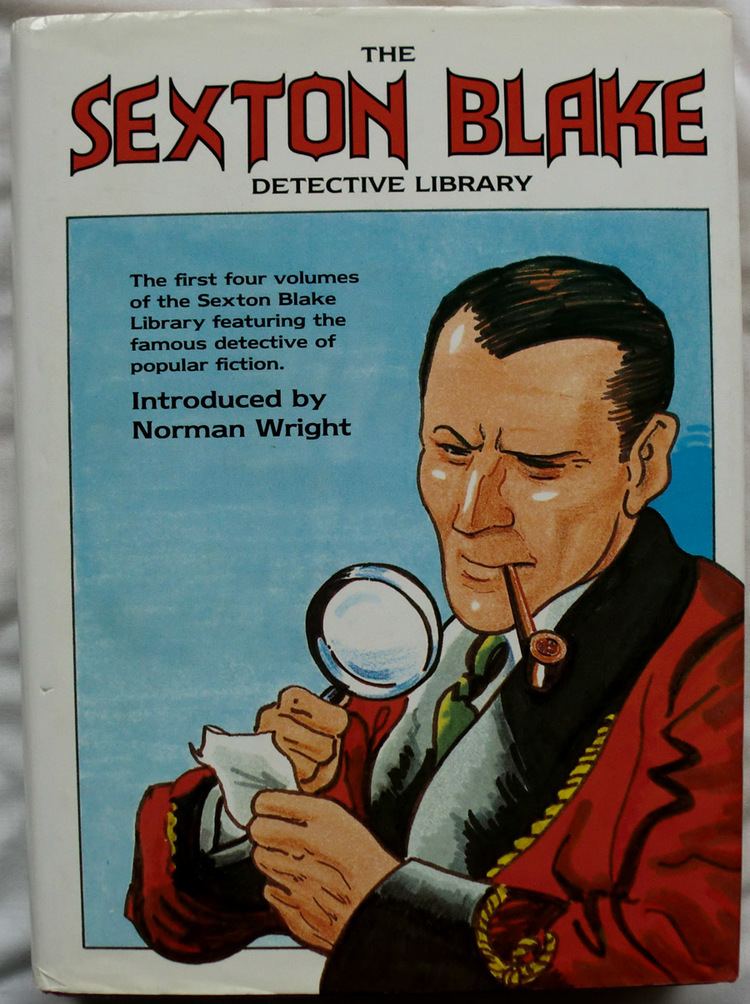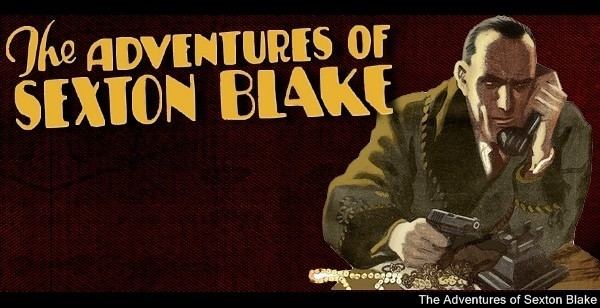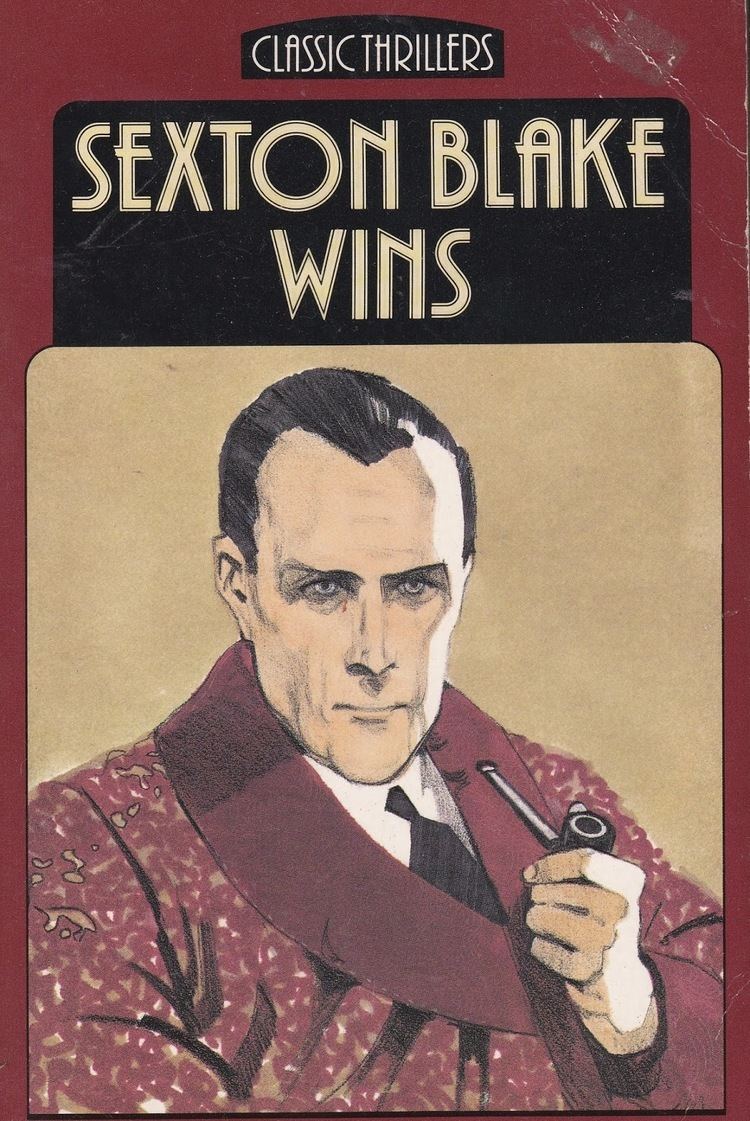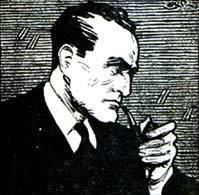Gender Male First appearance The Missing Millionaire | Nationality British Occupation Detective | |
 | ||
Created by Harry Blyth (as Hal Meredeth) Portrayed by Langhorn BurtonGeorge CurzonDavid FarrarGeoffrey TooneWilliam FranklynLaurence PayneJeremy ClydeSimon Jones Movies Sexton Blake and the Hood, Meet Sexton Blake, The Echo Murders, Sexton Blake and the Beard, Murder at Site 3 Similar Billy Bunter, Monsieur Zenith, Captain Hurricane, Bulldog Drummond, The Steel Claw | ||
Sexton Blake is a fictional character, a detective who has been featured in many British comic strips, novels and dramatic productions since 1893. Sexton Blake adventures were featured in a wide variety of British and international publications (in many languages) from 1893 to 1978, comprising more than 4,000 stories by some 200 different authors. Blake was also the hero of numerous silent and sound movies, radio serials, and a 1960s ITV television series.
Contents
- Publication history
- Blakes evolution
- Blakes associates
- Blakes enemies
- Stage
- Silent movies
- Talkies
- Radio
- Sexton Blake 196771
- Sexton Blake and the Demon God 1978
- Other Blake appearances
- References

Publication history

The first Sexton Blake story was "The Missing Millionaire". Written by Harry Blyth (using the pseudonym Hal Meredeth), it was published in the story paper The Halfpenny Marvel number 6, on 20 December 1893. He featured thereafter also in a few more stories by Meredeth.
His adventures were published subsequently in a variety of publications, primarily the magazine Union Jack, published first during April 1894. Blake featured in Issue 2 of Union Jack (with the title Sexton Blake, Detective) and beginning 1904 the character was featured regularly until Union Jack became Detective Weekly during 1933. Blake continued as the main feature until Detective Weekly ended during 1940.

Blake also featured in a number of serials in the magazine The Boys' Friend beginning 1905 and in the magazine Penny Pictorial from 1907 to 1913 (when that magazine ended). The Boys' Friend introduced the first truly lengthy stories (of as many as 60,000 words), allowing for greater plot and character development.

During 1907, a story entitled "Sexton Blake's Honour" dealt with Blake's pursuit of a criminal who turned out to be his brother, Henry Blake. Another bad brother, Nigel, was revealed during 1933 in the first issue of Detective Weekly, in a story titled "Sexton Blake's Secret".
With the popularity of school stories during this era, Blake's assistant Tinker had his schooldays chronicled in issues 229 and 232. Perhaps most famously, Blake featured in his own long-running magazine, The Sexton Blake Library, from 1915 to 1968 which was published in five "series". Publication was constant at 2–4 issues per month until the end of series 4 during 1964. Series 5, starting 1965, was a sporadic series of paperbacks.
The first issue of The Sexton Blake Library was published on 20 September 1915, entitled "The Yellow Tiger" and written by G.H. Teed. This issue introduced villains Wu Ling and Baron de Beauremon in an eleven chapter story, costing 3d (1.25p). The story is 107 pages; a second story, "The Great Cup-Tie!" (not featuring Blake) completes the remainder of the issue's 120 pages. The second issue, "Ill Gotten Gains (The Secret of Salcoth Island)", had Blake fight Count Carlac and Professor Kew. Issue three was entitled "The Shadow of his Crime" and issue four "The Rajah's Revenge". The last edition, "Down Among The Ad Men" written by W.A Ballinger (Wilfred McNeilly), was published during October 1968. Some additional Sexton Blake books were published during 1968 and 1969 that were not labelled explicitly as part of the Sexton Blake Library.
The majority of Sexton Blake Library covers (prior to editor William Howard Baker's 1956 revamp of the character) were painted by master Sexton Blake illustrator Eric Parker.
Writers who worked on Sexton Blake stories throughout this 53-year span included John Creasey, Jack Trevor Story and Michael Moorcock.
After Fleetway ceased publishing the Sexton Blake Library series at the end of its fourth volume during 1963, Blake editor William Howard Baker licensed the character from IPC company and published a fifth volume independently, via Mayflower-Dell Books, that ran until 1968. He then published a final series of four Sexton Blake novels, using his Howard Baker Books imprint, during 1969.
A series of 160-page Sexton Blake annuals, featuring old stories and new material, began during 1938 and lasted till 1941.
Blake comic strips featured in The Knock-Out Comic (later Knock-Out Comic & Magnet and, finally, simply Knockout) from 1939 to 1960. The Blake strip was illustrated originally by artist Jos Walker and then by Alfred Taylor, who illustrated Blake's adventures for ten years. The undoubted highlight of Blake's 21-year run in Knockout was a 14-part 1949 strip drawn by Blake's greatest illustrator Eric Parker, entitled "The Secret of Monte Cristo". This was Parker's only contribution to Blake's comic strip adventures.
There was one Super Detective Library story about Blake: issue 68 (published November 1955), featuring a comic strip entitled "Sexton Blake's Diamond Hunt".
Four hardbacks designed for the younger market were published by Dean & Son Ltd during 1968 (the third of these, "Raffles' Crime in Gibraltar", portrayed Blake contending with A. J. Raffles, E.W. Hornung's amateur cracksman).
A final Sexton Blake comic strip (initiated to tie in with the 1967–1971 television show) featured in IPC's weekly boys' anthology Valiant from January 1968 to May 1970.
A seven-part Blake comic strip featured in IPC's comic Tornado from March 1979 to May 1979. A contract dispute (subsequently resolved in IPC's favour) caused the Tornado editorial team to rename Blake as "Victor Drago" (and Tinker & Pedro as "Spencer & Brutus") for the duration of this strip.
During 2009, IPC's information manager, David Abbott, signed licenses to publish two Blake omnibus archive editions: The Casebook of Sexton Blake, published by Wordsworth Editions, and Sexton Blake, Detective published by Snowbooks.
During 2013, Obverse Books licensed the character for a proposed series of novellas, as part of a sixth series of the Sexton Blake Library, commencing with 'The Silent Thunder Caper' by Mark Hodder. The imprint had previously published a collection of short stories featuring Blake villain Zenith the Albino.
Blake's evolution
As the years passed, Blake's character experienced various permutations. He was originally created to be similar to earlier 19th-century detectives but during the late 1890s, Blake's authors consciously modeled him on Sherlock Holmes. It was not until 1919 that Blake was given a more distinctive personality. Blake became much more action-orientated than Holmes and duelled with a variety of memorable enemies.
Many of Blake's writers had been men of adventure who had travelled the world. When World War II started, they enlisted, leaving just a small group of writers behind (with the addition of the occasional guest writer). Consequently, the standard of Blake's stories suffered.
During November 1955, William Howard Baker became editor of the Sexton Blake Library and, during 1956, introduced a successful update of the Blake formula. The Sexton Blake Library found new popularity with faster-moving, more contemporary stories (often influenced by American pulp fiction).
Blake, who had been relocated a number of times over the years, was relocated to a suite of plush offices in Berkeley Square (while retaining lodgings at Baker Street) and acquired a secretary, Paula Dane, who became a not-quite-love interest for Blake. Tinker was given a real name, Edward Carter, and Blake's office receptionist Marion Lang was introduced as his female counterpart.
Covers, which had become rather staid during the early 1950s, became much more dynamic and a new group of authors were commissioned.
Baker remained as editor until 1963 (his last story being "The Last Tiger") before becoming Blake's licensor/publisher and continuing to oversee Blake's print adventures until 1969.
Blake's associates
Blake's first associate from The Halfpenny Marvel No. 6 ("The Missing Millionaire") is the Frenchman Jules Gervaise, who gives him the first recorded case. By issue No. 7 ("A Christmas Crime") they initiate an investigative company together. In the third story of issue No. 11 ("A Golden Ghost") Gervaise is not mentioned.
In Union Jack number 53, in a story titled "Cunning Against Skill", Blake picked up a wiry street-wise orphan as an assistant who was known only as "Tinker" until the 1950s. Over the years, Tinker changed from a boy and good fighter to a rugged and capable young man. As well as assisting the "guv'nor", as he called Blake, Tinker kept Blake's crime files up to date with clippings from the daily newspapers, in addition to assisting Blake in his fully equipped crime laboratory.
Other associates included Derek "Splash" Page of the Daily Radio; Ruff Hanson, a tough American investigator (both created by Gwyn Evans) and Blake's friends at Scotland Yard: Chief Detective Inspector Lennard, Detective Inspector Coutts and Superintendent Venner.
During 1905, Blake's bustling housekeeper Mrs Bardell (created by William Murray Graydon, who also created Pedro the bloodhound), was started and remained until the end. Her misuse of the English language was legendary in stories—- she was a gifted cook and would always be on hand if a client needed food or a cup of tea. Mrs Bardell even featured as the main character in stories such as: "The Mystery Of Mrs Bardell's Xmas Pudding" during 1925 and "Mrs Bardell's Xmas Eve" in 1926.
In Union Jack number 100 (9 September 1905), a story entitled "The Dog Detective" introduced Blake's faithful, wise and ferocious bloodhound, Pedro. Pedro was originally owned by Rafael Calderon, ex-president of a South American state, but after performing various services for Calderon Blake was given Pedro by Calderon, using the guise of "Mr. Nemo." Pedro tracked many villains to their lairs in subsequent stories.
Another notable non-human associate (and almost a character in itself) was Blake's bullet-proof Rolls-Royce, named The Grey Panther (introduced at a time when most other sleuths were still taking cabs). For a short while, Blake also flew a Moth monoplane (also called The Grey Panther and designed by Blake himself).
Blake's enemies
George Marsden Plummer (created by Ernest Semphill), a dishonest Detective Sergeant at Scotland Yard, opposed Blake, but like many others, Plummer ended in a police cell. Unlike many before him, he repeatedly escaped and became Blake's arch-enemy.
Another memorable character was Waldo the Wonderman (created by Edwy Searles Brooks), who started as a villain and ended in later stories as a friend of Blake's, helping him with a number of cases. This 1918 superman had tremendous strength, could contort his body like a rubber man and was insensitive to pain. Even after his reformation, he continued to steal money (but his victims were now blackmailers, swindlers and other no-good members of the underworld).
Other notable villains included the Byronic master thief Zenith the Albino (who had crimson eyes), Dr Huxton Rymer, and Leon Kestrel, the Master Mummer.
The type of villain Blake opposed changed with the times (as did Blake himself). After World War II, his opponents became more ordinary, their personalities and motives less fantastic. Veteran writers John Hunter and Walter Tyrer excelled at this type of writing, but others failed to maintain their standards.
Stage
There were several Sexton Blake stage plays:
Silent movies
There was also 'Britain's Secret Treaty' in which Sexton Blake recovers a stolen document.
Talkies
Radio
Sexton Blake (1967–71)
ITV broadcast Thames Television's Sexton Blake featuring Laurence Payne as Blake and Roger Foss as Tinker from Monday 25 September 1967 to Wednesday 13 January 1971. In keeping with Sexton Blake's classic print adventures, Payne's Blake drove a white Rolls-Royce named "The Grey Panther" and owned a bloodhound named Pedro. The show was produced originally by Ronald Marriott for Associated Rediffusion, with Thames Television assuming production during 1968.
Pedro was played by one or more bloodhounds (bitches), which doubled as 'Henry', for Chunky dog food advertisements with Clement Freud, and were owned by the then secretary of the Bloodhound Club, Mrs Bobbie Edwards.
During rehearsals for the show during 1968, Laurence Payne was blinded in his left eye by a rapier.
Typical of the TV series's sometimes-fantastic storylines (all of which lasted 2–6 episodes) was 1968's "The Invicta Ray" in which a villain dressed in a costume and hood of sackcloth-like material and, under the rays of The Invicta Ray, became invisible so that he could commit crimes without being seen.
Of 60 episodes, only the first episode is thought to exist still.
The cast:
Sexton Blake and the Demon God (1978)
Simon Raven's Sexton Blake and the Demon God was a six-part television serial produced by Barry Letts for the BBC during 1978. The serial was broadcast by BBC One at tea-time from Sunday 10 September 1978 until Sunday 15 October 1978 and was directed by Roger Tucker.
Jeremy Clyde played Blake, with Philip Davis appearing as Tinker and Barbara Lott playing Mrs Bardell.
